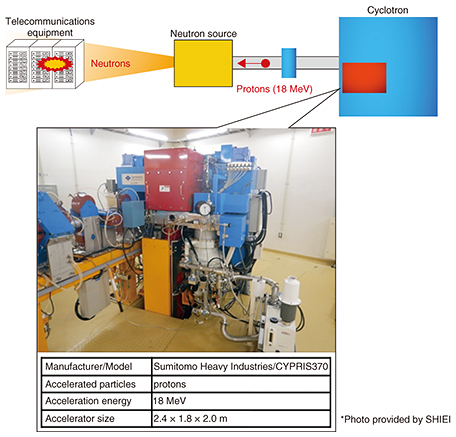 |
|||||
|
|
|||||
|
Short Reports Vol. 15, No. 5, pp. 54–55, May 2017. https://doi.org/10.53829/ntr201705sr1 Soft Error Test Service Commences to Reproduce Soft Errors—Abnormal Operation of Electronic Equipment Caused by Cosmic Rays1. IntroductionNTT, in partnership with Nagoya University and S.H.I. Examination & Inspection, Ltd. (SHIEI hereinafter), has verified the applicability of a compact accelerator-driven neutron source*1 available to general companies for reproducing faults of electronic equipment caused by cosmic rays (soft errors)*2 and has also established a test method to reproduce soft errors. In addition, NTT Advanced Technology Corporation (NTT-AT hereinafter) started a soft error test service using a compact accelerator-driven neutron source in December 2016. As telecommunications equipment becomes more compact and energy-efficient with higher functionality and performance, this service promises to improve equipment reliability by enabling the prediction of abnormalities caused by soft errors in the development and testing stage, as well as confirmation of error detection and remediation systems designed to cope with soft errors. There are also plans to expand the scope of this application to other types of electronic equipment requiring high levels of reliability.
2. BackgroundIn recent years, there has been strong demand for compact electronic equipment that conserves energy and has high functionality and high performance, meaning that semiconductor devices used in the equipment require high levels of integration. As semiconductor devices become more integrated and miniaturized, the electric charges required to determine bits in devices have become smaller and smaller. Meanwhile, the earth is constantly being showered with neutrons that occur as a result of cosmic rays colliding with the atmosphere. Consequently, the semiconductor devices are easily affected by tiny charges of the secondary particles in neutrons resulting from the cosmic rays. This means that the rate of soft errors is on the rise compared to that of older electronic equipment. NTT speculated that soft errors could be triggered intentionally using a compact accelerator-driven neutron source. Hence, soft error testing technology was jointly established at Hokkaido University’s compact accelerator-driven neutron source. As soft errors in telecommunications equipment gain an increasing amount of attention around the world, NTT Network Service Systems Laboratories has led standardization activities in the International Telecommunication Union, Telecommunication Standardization Sector (ITU-T). In fact, ITU-T K.124 “Overview of particle radiation effects on telecommunications systems” was approved as a Recommendation in December 2016. From these beginnings, NTT has continued joint research with SHIEI and Nagoya University in order to confirm that soft error testing is possible with a compact accelerator-driven neutron source owned by a general company, with the objective of commercializing a soft error testing service. The results of the research have enabled NTT-AT to begin providing a soft error testing service. 3. Joint experiment resultsThe SHIEI-owned compact accelerator-driven neutron source was used to conduct joint experiments in order to (1) reproduce soft errors, (2) greatly reduce the time to reproduce soft errors, and (3) build a system to control the area irradiated with neutrons (Fig. 1). In this experimental system, neutrons were produced by irradiating a beryllium target in a cyclotron with protons accelerated to 18 MeV.
Prior to the experiment, a particle transport simulation was performed to determine the spatial distribution of the neutrons. (1) Soft error reproduction We confirmed that soft errors could be reproduced using the SHIEI-owned compact accelerator-driven neutron source. (2) Significant reduction in soft error reproduction time Testing was done in the vicinity of the neutron generation source in this accelerator, and we verified that the time taken to reproduce soft errors was reduced to 1/100 that of the older method. This is equivalent to about 100 million times faster than that of the natural world. We also confirmed that this ratio can be freely adjusted. (3) Controlling the neutron irradiation area In this experiment, we confirmed that the irradiation area can be controlled to handle irradiation of particular LSI (large-scale integrated circuit) devices within a system, or irradiation of entire systems. Specifically, we confirmed that testing is possible with irradiation of only a specific area of a few square centimeters or a wide area of about 50 × 50 cm. For InquiriesPlanning Department, Public Relations Section, NTT Information Network Laboratory Group |
|||||

